Sadc to commission new power projects

The Southern African Development Community plans to commission new power projects that will add 4 000 megawatts of electricity to the regional grid in the coming year, as it strives to become energy self-sufficient. Countries in the region have been experiencing energy shortfalls over the years as power demand spiked, forcing most of them to implement demand side management programs such as load shedding which, however, has a negative effect on socio-economic growth, hence the need to boost generation capacity.
The Sadc region is estimated to have an electricity supply shortfall of around 8 200 MW.
Speaking at the just ended Sadc Heads of State and Government summit in Swaziland, Sadc executive secretary Dr Stergomena Lawrence Tax said during the past year, the region commissioned about 1 700 MW in new generation.
“In the coming year, it is envisaged that new power generation amounting to about 4 000 MW will be commissioned,” he said.
“This phenomenal increase in power generation, the highest ever in the region to date, will contribute immensely towards alleviating the current power deficit in the region.”
The Southern African Power Pool (SAPP), of which Zimbabwe is a member, coordinates the planning, generation and transmission of electricity on behalf of utilities of member states.
All mainland Sadc countries except Angola, Malawi and Tanzania, are interconnected through the SAPP regional grid, allowing them to share surplus energy.
However, new generation capacity installed in any of the three non-participating countries is not accessible to the SAPP members, comprising the Democratic Republic of Congo, Lesotho, Mozambique, Namibia, Swaziland, South Africa, Zambia and Zimbabwe.
On its part, Zimbabwe is building new power stations as well as expanding existing ones to bridge the energy deficit in the country.
Zimbabwe is currently expanding the Kariba hydro-power station to add an additional 300 megawatts of electricity to the national grid, while Hwange thermal power station will also be expanded to add 600 MW.
The new Kariba plant is expected to start generating in 2017. – New Ziana.










Comments